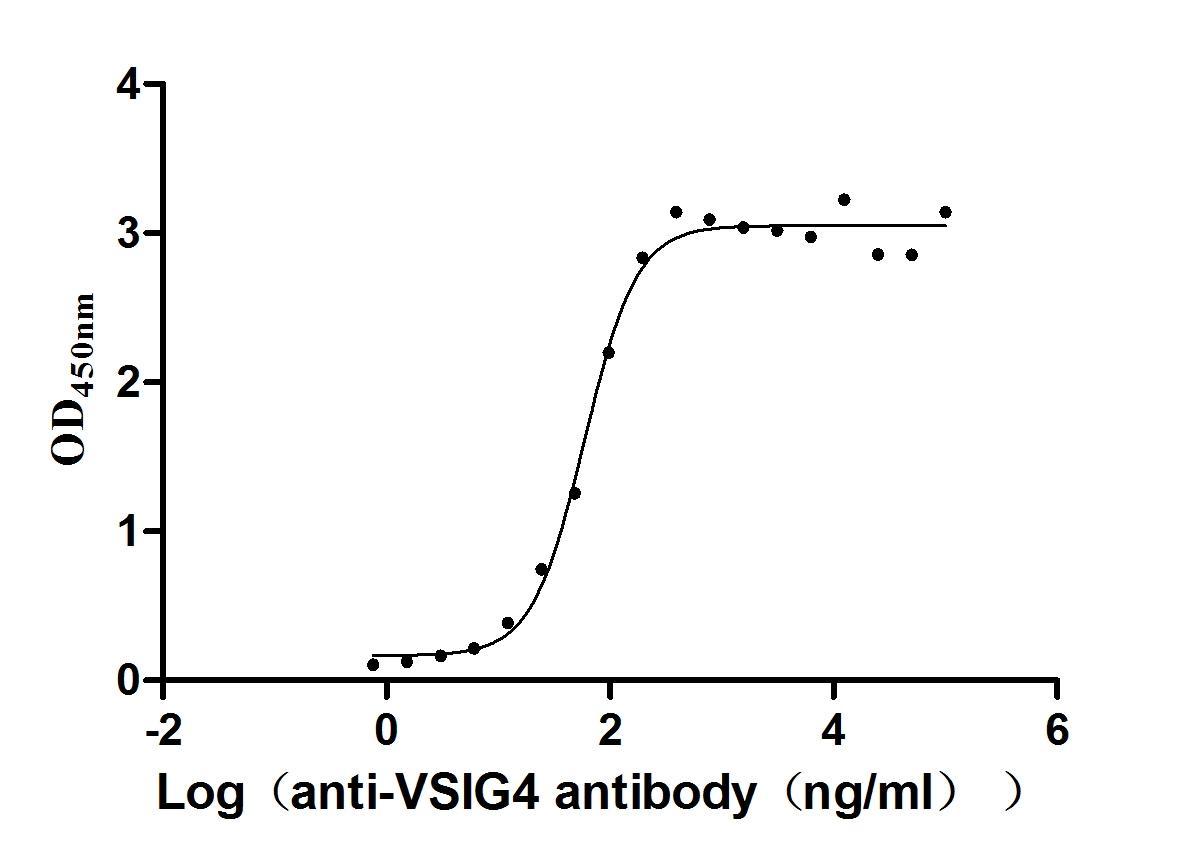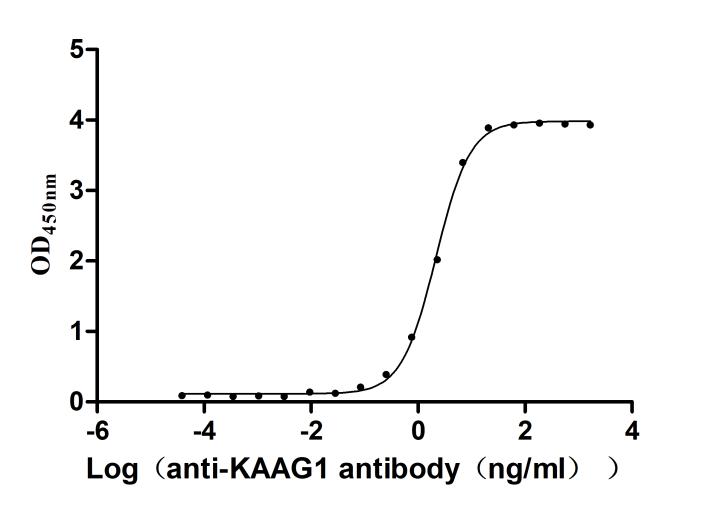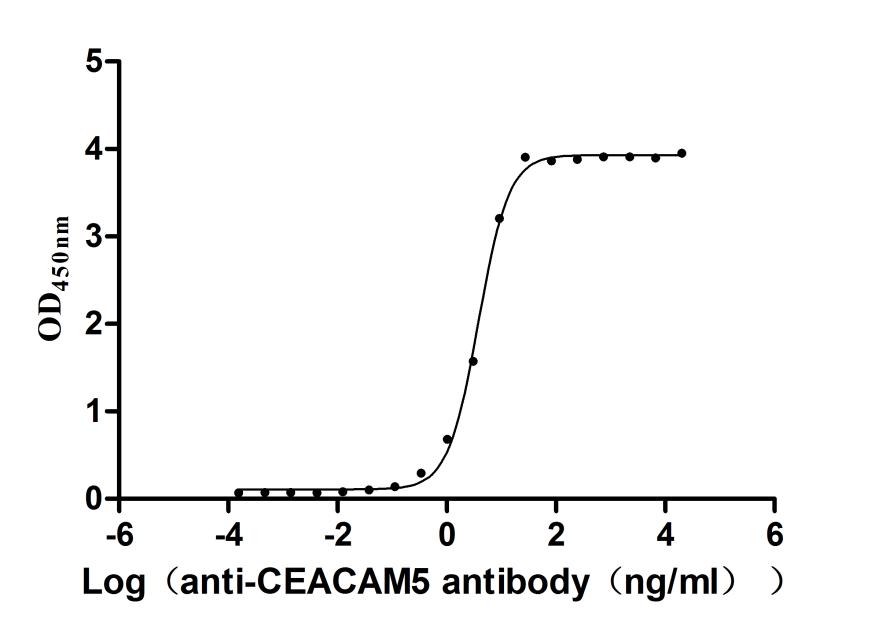Recombinant Mouse Eotaxin protein (Ccl11)
In Stock-
中文名稱:Recombinant Mouse Eotaxin protein(Ccl11) (Active)
-
貨號(hào):CSB-AP001291MO
-
規(guī)格:¥852
-
圖片:
-
其他:
產(chǎn)品詳情
-
純度:>96% as determined by SDS-PAGE.
-
內(nèi)毒素:Less than 1.0 EU/μg as determined by LAL method.
-
生物活性:Fully biologically active when compared to standard. The biological activity determined by a chemotaxis bioassay using purified eosinophils is in a concentration range of 100-1000 ng/ml.
-
基因名:Ccl11
-
Uniprot No.:
-
別名:Ccl11; Scya11Eotaxin; C-C motif chemokine 11; Eosinophil chemotactic protein; Small-inducible cytokine A11
-
種屬:Mus musculus (Mouse)
-
蛋白長(zhǎng)度:Full Length of Mature Protein
-
來(lái)源:E.Coli
-
分子量:8.4 kDa
-
表達(dá)區(qū)域:24-97aa
-
氨基酸序列HPGSIPTSCC FIMTSKKIPN TLLKSYKRIT NNRCTLKAIV FKTRLGKEIC ADPKKKWVQD ATKHLDQKLQ TPKP
-
蛋白標(biāo)簽:Tag-Free
-
產(chǎn)品提供形式:Liquid or Lyophilized powder
Note: We will preferentially ship the format that we have in stock, however, if you have any special requirement for the format, please remark your requirement when placing the order, we will prepare according to your demand. -
緩沖液:0.2 μm filtered PBS, pH 7.4 ,lyophilized
-
儲(chǔ)存條件:Store at -20°C/-80°C upon receipt, aliquoting is necessary for mutiple use. Avoid repeated freeze-thaw cycles.
-
保質(zhì)期:The shelf life is related to many factors, storage state, buffer ingredients, storage temperature and the stability of the protein itself.
Generally, the shelf life of liquid form is 6 months at -20°C/-80°C. The shelf life of lyophilized form is 12 months at -20°C/-80°C. -
貨期:5-10 business days
-
Datasheet & COA:Please contact us to get it.
相關(guān)產(chǎn)品
靶點(diǎn)詳情
-
功能:In response to the presence of allergens, this protein directly promotes the accumulation of eosinophils (a prominent feature of allergic inflammatory reactions), but not lymphocytes, macrophages or neutrophils. Binds to CCR3.
-
基因功能參考文獻(xiàn):
- the adipose-derived FGF21-CCL11 axis triggers cold-induced beiging and thermogenesis by coupling sympathetic nervous system to activation of type 2 immunity in subcutaneous white adipose tissue. PMID: 28844880
- CCL11 promotes migration and proliferation of mouse neural progenitor cells. PMID: 28173860
- These studies characterized serum and intestinal wall eotaxin-1 levels in various inflammatory bowel disease patients and to explore the effect of targeting eotaxin-1 by specific antibodies in dextran sodium sulfate-induced colitis model. PMID: 26874691
- this study shows that eosinophil trafficking to the heart is dependent on the eotaxin-CCR3 pathway in a mouse model of experimental autoimmune myocarditis PMID: 27621211
- Blocking antibodies against RANTES and eotaxin reduced the infiltration of CD4(+) and CD8(+) T cells into the nigra, attenuated nigral expression of proinflammatory molecules, and suppressed nigral activation of glial cells. These findings paralleled dopaminergic neuronal protection, normalized striatal neurotransmitters, and improved motor functions in MPTP-intoxicated mice. PMID: 27226559
- These results indicate that CCL11 was responsible for the limited angiogenesis and necrosis by inducing and attracting eosinophils in the tumors. PMID: 27169545
- Study demonstrated that CCL11 is primarily produced by activated astrocytes in the CNS, activates microglia to produce ROS via NOX1, and exacerbates excitotoxic neuronal death PMID: 26184677
- PAR2 activation through endogenous mast cell tryptase activity could be required, at least partially, to mediate CCL11-induced eosinophil migration PMID: 24972241
- The chemokines monocyte chemotactic protein 1 (MCP1), MIP1alpha, MIP1beta, interferon gamma-induced protein 10 (IP-10), and eotaxin were induced in Saa1 TG mice. PMID: 25847238
- investigated role of Eotaxin-1 on disease outcome in Litomosoides sigmodontis infection; findings suggest, in Eotaxin-1(-/-) mice, potential reduced activation state of eosinophils; macrophages produce decreased amounts of IL-6 in vitro suggesting possible mechanisms by which Eotaxin-1 regulates activation of inflammatory cells and parasite survival PMID: 24112106
- Autologous transfer of peritoneal macrophages in to the airways of asthmatic mice reduces eotaxin production. PMID: 24077949
- TNC expression controls eotaxin level in apo E-/- mice and that this chemokine plays a key role in the development of atherosclerosis PMID: 23433402
- Data indicate that the combination of Ovalbumin (OVA) and hypoxia induced a enhanced expression of HIF-1alpha and increased eotaxin-1, lung TGB-beta1 expression, and indices of airway remodeling. PMID: 23499929
- increased sputum and nasal lavage fluid levels in allergic rhinitis subjects PMID: 21703102
- These studies demonstrate that inflammatory monocyte/macrophage-derived CCL11 drives colonic eosinophilic inflammation in experimental colitis. PMID: 21498668
- The oesophageal production of CCL11 upon IL-13 stimulation is sufficient to promote eosinophil migration. PMID: 20030665
- Data show that that augmented airway eosinophilic inflammation and hyperresponsiveness in RV-infected mice with allergic airways disease is directed in part by eotaxin-1. PMID: 20644177
- eotaxin initiates allergic airway disease due to A. fumigatus, but this chemokine did not appear to contribute to the maintenance of A. fumigatus-induced allergic airway disease. PMID: 12060577
- concentrations of eotaxin in the CSF of Angiostrongylus cantonensis infected mice each week after infection were all significantly higher than those in serum ( P<0.0001). PMID: 14648203
- CCL11 is a potent chemotactic factor for smooth muscle cells. Because CCL11 is expressed abundantly in SMC-rich areas of the atherosclerotic plaque and in injured arteries, it may play an important role in regulating SMC migration. PMID: 15130922
- infection of mice by Histoplasma capsulatum induced rapid generation of high levels of MIP-1alpha, which remained elevated from 4-48 h whereas very little eotaxin was detected at any time point PMID: 15316665
- critical role for eotaxin-1 in Brugia malayi microfilaria parasite clearance PMID: 15593125
- Distinct acidic and basic residues within CCR3 determine both receptor expression and activation by the eotaxins. PMID: 16102831
- The eotaxin-1 pathway plays a fundamental role in eosinophil recruitment during ovalbumin-induced experimental asthma. PMID: 16210640
- CCL11 and CCR3 are important in the pulmonary recruitment of granulocytes and play significant pathogenic roles in bleomycin-induced lung fibrosis. PMID: 16314464
- IL-4 induction and the IL-4/OSM synergistic induction of eotaxin-1 was abrogated in STAT6(-/-) mouse lung fibroblasts, however, regulation of IL-6 was similar in -/- or wild-type mouse lung fibroblasts PMID: 16547273
- CCL11 is the salient but not the sole eosinophil chemoattractant of biological significance during gastrointestinal helminth infection. PMID: 16783848
- eosinophils via chemokine (C-C) receptor 3 have a central role in chronic allergic airway disease PMID: 17060636
- In the absence of eotaxin-2 or CCR3, there was a profound reduction in IL-13-induced eosinophil recruitment into the lung lumen. In the absence of eotaxin-1, there was a fourfold increase in IL-13-mediated eosinophil recruitment into the airway. PMID: 17148674
- There was a higher tumor incidence in CCL11(-/-) BALB/c mice, which was associated with a reduced eosinophil influx into tumors. PMID: 17371978
- Heligmosomoides infection led to reduction in number of lung eosinophils with decreased levels of eotaxin in bronchoalveolar lavage fluid, lowered of CCR3 receptor expression on eosinophils and impaired chemotaxis of these cells toward eotaxin. PMID: 17650182
- induction of eotaxin-1 and CD4+ T cell production of IL-5 are required for respiratory syncytial virus G glycoprotein-induced eosinophilia following respiratory syncytial virus challenge. PMID: 18519743
- Specific inhibition of CCL11 alone is therefore unlikely to inhibit eosinophil recruitment to the airways. PMID: 18850374
- Data show thatprimary or secondary resistance were unaffected at either the pre-lung or gut stages of infection in eotaxin(-/-) single mutant mice. PMID: 19535141
顯示更多
收起更多
-
亞細(xì)胞定位:Secreted.
-
蛋白家族:Intercrine beta (chemokine CC) family
-
組織特異性:Expressed constitutively in the thymus. Expression inducible in the lung (type I alveolar epithelial cells), intestine, heart, spleen, kidney.
-
數(shù)據(jù)庫(kù)鏈接:
Most popular with customers
-
Recombinant Human Signal transducer CD24 (CD24)-Nanoparticle (Active)
Express system: Mammalian cell
Species: Homo sapiens (Human)
-
Recombinant Human Microtubule-associated protein tau (MAPT) (Active)
Express system: Mammalian cell
Species: Homo sapiens (Human)
-
Recombinant Human V-set and immunoglobulin domain-containing protein 4 (VSIG4), partial (Active)
Express system: Mammalian cell
Species: Homo sapiens (Human)
-
Recombinant Human Cadherin-6(CDH6),partial (Active)
Express system: Mammalian cell
Species: Homo sapiens (Human)
-
Recombinant Human Kidney-associated antigen 1(KAAG1) (Active)
Express system: E.coli
Species: Homo sapiens (Human)
-
Express system: Mammalian cell
Species: Macaca mulatta (Rhesus macaque)




-AC1.jpg)














